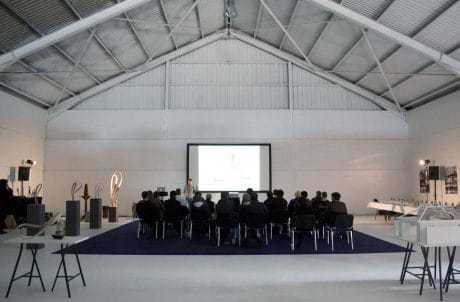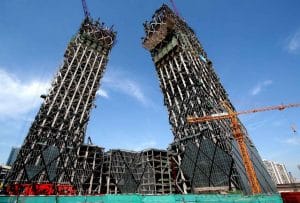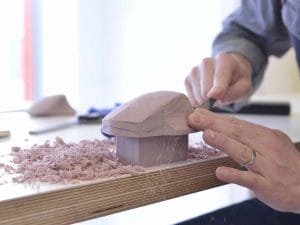Blog

Decoding Craftsmanship
After returning from a two-day seminar near Cork at Joseph Walsh’s Studio, entitled ‘Decoding Craftsmanship’ I am feeling refreshed and inspired. Although seeing Joseph’s exceptional work up close was a real treat, exploring the topic of the relationship between the maker and the digital technologies that are driving 21st century production was what made it an easy decision to travel over to the South of Ireland.
Bit by bit I have started to embrace computer-aided design and manufacture and it has become a regular part of my process. However as my designs become more complex, the last thing I want to do is lose the connection with the material and let the technologies run the operation. The seminar welcomed renowned contributors, providing me with a range of opinions on the emerging technologies, all of which were enlightening and diverse towards the future of maker culture.
Maintaining a design’s spirit in digital
Joseph talked initially about how important it was to maintain the spirit of his sketches as the design process started to engage with digital technologies. Working the practicalities of both the materials’ characteristics and the software’s capabilities into the design without losing the essence of the idea was where the crux of the issue lay. With various scale models of his latest seven metre tall commission, he stressed the importance of the maquette and its evolution whilst still keeping one eye on the original concept. Misoslav Hlava, one of Joseph’s computational design team, explained some of the initial stages of taking some of the early sketch models into software such as Rhino and Grasshopper so that stresses and strains of such large pieces could be analysed. Modelling and analysing such free form curves accurately is no easy feat despite Miroslav making it look a simple task.
The director of Arup Dublin, Peter Flynn, introduced the theme of tolerance and how “design is about planning for what could go wrong”. This was highlighted beautifully with examples of Joseph’s work being tested for the effects of torsion as well as how two colossal towers were joined to make one building (CCTV Headquarters in Beijing) by waiting for the right climatic conditions, clearly preceded by an enormous amount of planning! The technology treats the materials with defined dimensions and orientations but the craftsman, engineer and architect must allow for movement or come face to face with failure. Peter finished by pointing out that just because we have these powerful technologies to hand doesn’t mean that we should overuse them, with the “over elaborate” design of the Nissan Duke being used to illustrate his point.
Creating an immersive digital experience
Thomas Bryans, director of IF_DO introduced the theme of Virtual Reality and how with the use of digital he is now able to allow his clients to enter into the virtual world of his computer models so that they can look around his architecture as if they are actually there. The ability to use this tool for the “immersion effect” is proving to be an increasingly powerful sales tool in the world of design but also being able to bring home other causes such as the plight of refugees and the living conditions that they have to endure, by allowing us to empathise more easily.
I engaged in a workshop about the powerful modelling tool, Rhino with Phil Cook from Simply Rhino. There is an art to accurately representing beautiful flowing curves and Phil explained how the tools of Rhino can help the designer “weight” the rate of change of arcs and freeform curves. The difference between control and edit points became crystal clear and why having as few control points as possible is vital to having a smooth flowing object. He demonstrated various commands that allow the user to create complex surfaces and then edit them in a more fluid way. Parametric programmes such as Solidworks allow for fluid editing but don’t really mimic the hands on designing and making process in the same way that Rhino does. The History command now enables various stages of construction to be manipulated at the same time thus being a way of bridging this parametric gap. Although not as powerful as Grasshopper, which we discovered on day two, when illustrating the Blend Surface command with History enabled it showed the real power of this incredible programme. The point that Thomas had previously made that technology is a tool for design but should not be used as a driver of design, became much more relevant as Phil demonstrated Rhino’s capabilities.
This point became even more apparent with the workshop on Grasshopper presented by Arthur Mamou-Mani of Simply Rhino. He demonstrated its abilities to match virtual geometry with coded parameters to create very complex forms. As we modelled both curved lines and surfaces with multiple divisions and control points, with the movement of a “number slider” the model would rotate, multiply arms and form complex lofts effortlessly. By the end of the session I had started to develop an understanding of how it works but felt that its danger was that by being able to manipulate a whole host of parameters, the final design could be a long way from the initial concept.
The importance of physical prototyping
Cathal Loughnane of Design Partners came armed with a collection of components that showed the process of designing Logitech’s state of the art computer mice. His initial training was as a sculptor before moving into product design and it was refreshing to see that the early part of the process was moving from sketch to sculpting, before 3D scanning his model and moving onto the digital iterations. A piece that is going to be in a user’s hand all day has to look great but also feel just right and his will to get his hands on the material right at the beginning of the process tied in with the theme of the whole seminar.
Similarly Peter Sheehan of Peter Sheehan Studio, although having adopted some of digital technologies came across as very wary of the extent that digital technology should be a part of the process. His collaboration with Joseph Walsh and Cathal Loughnane for the History Chair demonstrated the importance he places on the initial sketch, the maquette and the 1: 1 scale prototyping phases and how these need working and reworking before the digital side takes over.
Gergely Kovacs, head of computational design at Heatherwick Studios introduced some of their recent projects demonstrating that even though the scale of their work has increased from small pieces of furniture to giant mixed use architectural developments, the same issues of how the material will lead a project more than the digital design, surfaced again. This was illustrated perfectly with the Extrusions Chair, using a new manufacturing process, which squeezes aluminium through a die like toothpaste coming out of a tube. The initial section came out warped and rather than discarding this section, they chose to use this part, with each piece having its own original identity.
Reflection
After two days of talks, workshops and discussions I was reminded of the process that has become apparent during the recent development of my soon to be released Genie shelf. However much work was done in the software, nothing compared to experimenting with the corner of an offcut, prototyping and creating a first version when moving a design forward. The hands on manipulation of the material, slows the maker down to having a closer more intuitive connection with the material, which cannot be replicated from behind a computer screen. Despite the technology being there to aid in the process it is inevitable that it will play a part in the final outcome of a piece. The software allows us to see things that we may not have seen before and being able to “unsee” them isn’t possible. Being influenced by technology is inevitable but what became apparent to me was that over immersion leads to a lack of authenticity of direction in the design process. The use of digital technology is in an important part of the design (and production) process but for me is best consigned to the rational left side of the brain. The feeling that a design creates is usually born in an nonjudgmental expressive state of mind whether this is at the sketch phase or during 3D scale maquettes, which emanates from the right side of the brain. The challenge of maintaining the “feeling” is always going to be there, when the brain constantly flits from right to left side activities but as Joseph pointed out early on, the objective should be to stay true to the spirit of the initial idea.


